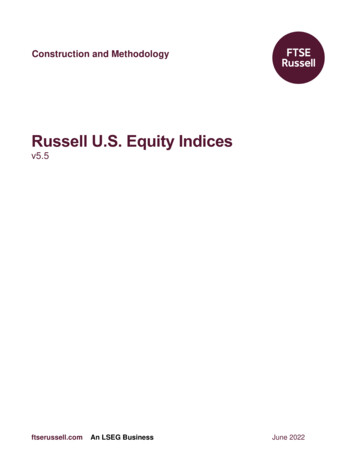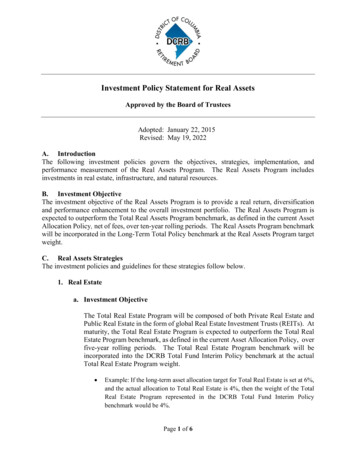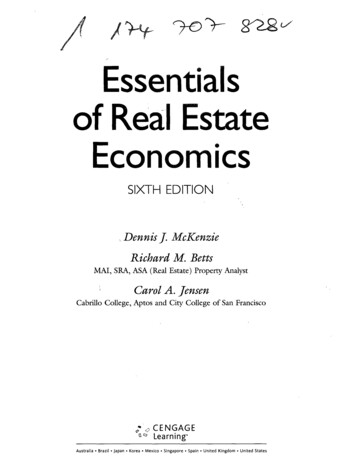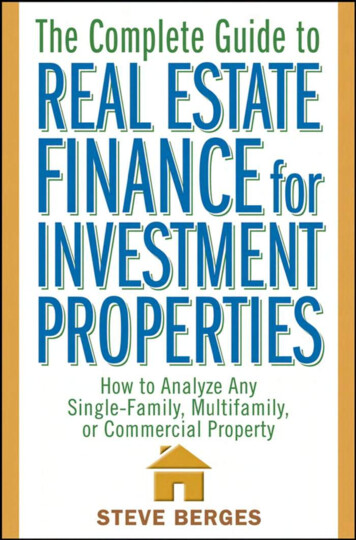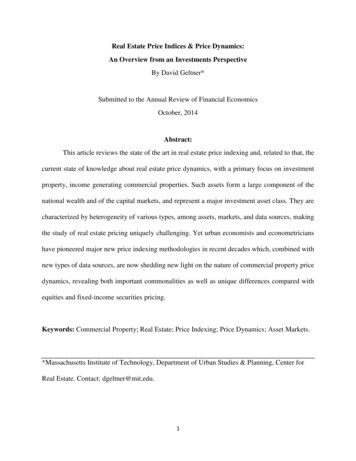
Transcription
Real Estate Price Indices & Price Dynamics:An Overview from an Investments PerspectiveBy David Geltner*Submitted to the Annual Review of Financial EconomicsOctober, 2014Abstract:This article reviews the state of the art in real estate price indexing and, related to that, thecurrent state of knowledge about real estate price dynamics, with a primary focus on investmentproperty, income generating commercial properties. Such assets form a large component of thenational wealth and of the capital markets, and represent a major investment asset class. They arecharacterized by heterogeneity of various types, among assets, markets, and data sources, makingthe study of real estate pricing uniquely challenging. Yet urban economists and econometricianshave pioneered major new price indexing methodologies in recent decades which, combined withnew types of data sources, are now shedding new light on the nature of commercial property pricedynamics, revealing both important commonalities as well as unique differences compared withequities and fixed-income securities pricing.Keywords: Commercial Property; Real Estate; Price Indexing; Price Dynamics; Asset Markets.*Massachusetts Institute of Technology, Department of Urban Studies & Planning, Center forReal Estate. Contact: dgeltner@mit.edu.1
Table of Contents:1. Introduction & Background . . 32. Some Considerations About Real Estate Asset Markets . 63. Pricing and Price Indexing in the Property Asset Market 134. Methodology of Property Price Indexing . 195. Some Findings from Property Price Indices 246. Conclusion . 28Literture Cited . 302
Real Estate Price Indices & Price Dynamics:An Overview from an Investments PerspectiveDavid Geltner1. INTRODUCTION & BACKGROUNDThis article will focus on asset price indices and price dynamics in real estate. Though wewill not ignore owner-occupied housing, the main focus will be investment real estate, that is tosay, income-producing properties of the type and scale that are widely traded among professionaland institutional investors. We will use the term “commercial property” or “commercial realestate” (CRE), with the understanding that this includes multi-family residential rental incomeproperties held in the private sector. We will make some international observations, but the mainfocus will be on the United States.Commercial real estate equity has become a major asset class in professionally managedinvestment portfolios such as those of pension funds, sovereign wealth funds (SWFs), lifeinsurance companies, and other financial institutions. The market value of the stock of all realestate in the U.S. is often said to equal about one-third of all investible wealth assets, and toexceed the value of all publicly-traded equities (stocks). (Miles & Tolleson, 1997.) As of 2012the U.S. Bureau of Economic Analysis National Balance Sheet (BEA 2014) lists a total currentcost net value of over 32 trillion for structures alone. If we assume, consistent with Davis andPalumbo (2008), that land value is on average at least equal to the value of the structures on theland, this implies total real estate value of over 60 trillion, four times the annual GDP. To putthis in perspective, the 2013 Federal Reserve Bank Flow of Funds Matrix (FRB 2014) lists totalfinancial assets of 195 trillion, including 34 trillion of corporate equities, suggesting that realestate would be about a third of total assets and almost twice the value of all corporate equities.3
Approximately half of the total real estate asset value is owner-occupied housing, but that stillleaves over 30 trillion in commercial property of various types. Most commercial real estate isowned by private or government enterprises for their own use (owner-occupied commercialproperty, sometimes referred to as “corporate real estate”). A recent private enumeration of CREasset value by Florence et al. (2010) based on the CoStar Group Inc database which seeks tocapture all commercial properties in the U.S. found total CRE value (including multi-familyrental) of approximately 11 trillion as of 2009, the low point of CRE value in the GreatFinancial Crisis (GFC). It is reasonable to assume that about half by value of the CoStarenumeration was largely non-traded corporate and owner-occupied real estate (mostly smallerproperties). Considering that the FRB reports approximately 3.3 trillion CRE mortgage debtoutstanding in 2013, these findings are also consistent with an approximate magnitude of at least 6 trillion for traded investment CRE assets in the U.S. (assuming average outstanding loan-tovalue of about 50%). This compares to 2014 NYSE market capitalization of 16.6 trillion, 9.7trillion of U.S. corporate bonds outstanding, 3.7 trillion of municipal bonds (SIFMA 2014). Thepoint is, CRE is a major investment asset class by market value of the stock of assets.In spite of this, relatively little academic research attention has focused on CRE. When,beginning in the 1950s and 60s, financial economics emerged as a rigorous discipline from itsorigins in general economics, its focus was largely on stocks and bonds and their derivatives asthe subjects for investment theory and capital market theory, and this still remains largely truetoday. When, in the 1970s and 80s, real estate economics emerged as a rigorous field from itsorigins in micro-economics and in urban and spatial economics, its focus was largely on housingand the commercial space usage (rental) market rather than on the commercial property assetmarket, and this still remains largely true today. It was not until the late 1980s and the 1990s that4
modern financial economic theory began to be rigorously applied to the study of commercialproperty asset markets. Some pioneering studies included those by Ibbotson & Siegel (1984),Hartzell et al. (1986), Firstenberg et al. (1988), Geltner (1989), Liu et al. (1990), Ross & Zisler(1991), Giliberto (1992), Gyourko & Keim (1992), Giliberto & Mengden (1996), and Ling &Naranjo (1997). The pioneering textbook for this integration of financial economics and realestate economics was Geltner and Miller (2001, presently Geltner at al. 2014), though earlierstrands of academic literature notably included publications coming out of the appraisalprofession (see Lusht 1988, 1997). Even today the quantity, quality, depth and breadth of CREasset market academic literature remains relatively lean. But it is in this modern fusion offinancial economics and urban economics that we find the important academic work on CREprice indices and price dynamics, with the academic literature importantly supplemented byindustry research and development. This integrated field of literature forms the source fromwhich this review article is primarily drawn.With the above background in mind, this article will proceed in four sections and aconclusion. Section 2 will present some important considerations about investment property assetmarkets. Section 3 will present basic conceptual and definitional issues about price indexing ofCRE and some implications regarding price dynamics. Section 4 will briefly review the majormethods and considerations for producing real estate price indices. Section 5 will discuss someinteresting results of CRE price indexing including a brief comparison to housing andinternational results. Section 6 concludes.5
2. SOME CONSIDERATIONS ABOUT REAL ESTATE ASSET MARKETSTo begin, it will be instructive to consider why CRE assets have remained largely outsidethe spotlight of mainstream financial economics. An important reason is the nature of themarkets in which the assets are traded. Broadly, it might be said that there are three major typesof markets in the world. First, there are the markets for mobile or perishable goods and forservices and information, which are the major and most widespread markets studied in microeconomics. Such markets have been around since ancient times, and are arguably a natural andomnipresent institution of human culture, from the agora of ancient Greece and bazaars of theMiddle East to the Walmarts and internet of today. All of these goods markets share fundamentalcommonalities across history and across cultures, enabling very general and widely applicableconclusions to be drawn from studying them, about supply and demand, equilibrium pricing,competition, and so forth. Second, there are public securities markets or exchanges, for stocks,bonds, commodity contracts, and derivatives. Such institutions are a relatively new andspecialized invention in human history, dating largely only from the seventeenth or eighteenthcenturies. Public securities exchanges form the main focus of the capital markets andinvestments theory branch of modern financial economics. Like goods markets, securitiesmarkets share fundamental commonalities across history and countries, facilitating theirscientific study. Securities markets have a place in CRE price indexing and the study of CREprice dynamics, as we will note in this article, but they are not our central or fundamental focus.It is the third major type of market, the private real estate market (or “property market,”meaning, the market for the ownership of real property assets, land parcels including thepermanent structures on them) that must be our main focus, and whose unique characteristicsexplain why CRE has been relatively ignored by mainstream financial economics.6
Real property asset markets are very widespread, and in many countries go back manycenturies. But they are not nearly as ancient as real property ownership itself and the transfer ofsuch ownership. Human beings are territorial creatures. Until the industrial revolution almost allincome and wealth, and therefore power, derived from land. The control, effectively theownership, of land was certainly exchanged since ancient times, but it was not usually done soby the market mechanism. Blood was the exchange mechanism, whether by warfare, marriage,or inheritance. As civilization progressed, more and more of the exchange of real property beganto occur voluntarily in return for payment, and markets arose. But in many countries they aroseout of elements of the local culture different from the local goods markets. Nor did real estategenerally find its exchange through public securities markets (even where these existed). As aresult, unique institutions, customs and procedures arose for real property markets that can differnotably across countries. This heterogeneity makes scientific study more challenging.In some places, the “markets” for exchanging real estate may involve pricing that stilldefers more to traditional formulas than to what economists would regard as the free intercourseof supply and demand that results in free market equilibrium pricing such as prevails in goodsmarkets and public securities exchanges. Freely functioning (sometimes referred to as “arm’slength”) real estate markets that reasonably well reflect the economist’s concept of equilibriumpricing have the most history and ubiquity in the Anglo-Saxon countries and some lands ofnorthern and western Europe, though modern real estate markets are becoming more widespreadaround the world. But even in places like the United States, which has among the most activeand unfettered real estate markets in the world, there may be pricing influences from professionalappraisal practice which go back far in time and reflect more traditional procedures. Indeed, acharacteristic of real property markets is that there is often an entrenched specialized pricing7
profession, referred to as “appraisal” or “assessment” or “valuation,” which has varying degreesof influence in the actual conduct and operation of the market. Though this influence cansometimes be a bit exogenous to internal market equilibrium forces, appraisals can oftennevertheless be tapped as a unique source of information about CRE prices and values over time.The point is that the nature and functioning of real estate asset markets not only differsfrom that of public securities markets but also is more heterogeneous across countries.Furthermore, the nature of real estate markets has meant that it is much more difficult to observeand obtain large quantities of pricing and trading data, compared to what is possible for the othermajor types of markets. This is because assets are traded in deals that are private, generallybetween one buyer and one seller. While some jurisdictions require the public recording of theprice and of some characteristics of the traded asset, this requirement is not ubiquitous, and, hasnot generally resulted in a centralized, easily compiled database (though progress is being madein this regard). These features have no doubt made CRE a less appealing subject for study byacademic financial economists.Another feature of the property market is that it trades unique, whole assets each one ofwhich is traded (and therefore priced) only infrequently and irregularly through time. This posesan intellectual challenge to the construction of price indices necessary for the study of the assetclass’ pricing dynamics. While this challenge may be regarded by some financial economists as abarrier, it was, in effect, welcomed by urban economists as a fascinating problem to solve. Andsolve it they have, to a considerable degree, as we will review in this article. The infrequenttrading of unique long-lived assets also gives rise to the need to value (that is, to evaluate, orestimate the value of) CRE assets more frequently than they are traded priced in the market byactual consummated ownership exchange transactions. This need is a major raison d’être for the8
appraisal profession, which as previously noted can also be a source of information useful for ourpurposes.To make this consideration of real estate markets more concrete for our purpose ofunderstanding price dynamics, suppose you own a CRE asset, “123 Sesame Street,” and youwant to sell it. Unlike when you want to sell a stock or bond you might own, you can’t sell yourproperty immediately. You will hire a broker, who will put together an information packageabout the property and disseminate it in various ways, probably requesting written sealed bids bya certain date (likely several weeks or months in the future). You may or may not have posted asuggested minimum bid, or alternatively, an offer price, as this depends on the selling strategyyou and your broker have decided on based on the nature of the property, the condition of themarket, and how urgently you desire to sell the property. You have probably recently engaged aprofessional appraiser who has given you advice on what she thinks is the “most likely” or“expected” price at which the property will sell. (This is referred to as a “market value”appraisal.)Your sale of 123 Sesame Street is in competition with other similar properties nearby andnot so nearby, competing for the investment dollars of various possible types of buyers, whichmight include private taxable investors, investment managers working for tax-exempt pensionfunds or various types of private equity funds, REITs, life insurance companies buying for theirown account, foreign investors, and so on. Some of these buyers might be counting on borrowingmoney in the commercial mortgage market, and/or bringing in equity joint venture partners, inorder to come up with the cash they will need to make the purchase. The easier it is for yourpotential buyers to raise their sources of capital, the more potential buyers you will have and,ceteris paribus, the lower will be the opportunity cost of capital (OCC) and the higher will be the9
price you are likely to be able to negotiate. The reason why 123 Sesame Street is in competitionnot just with close-by properties but also with some that could be quite distant, is because manyof these potential buyers can place their capital anywhere they think they find the bestinvestment.When you receive the sealed bids, you will probably select a few of the most appealingones, based both on the bid price and also on other terms and conditions of the bid, and also onthe reputation you can ascertain about the bidder’s ability and propensity to expeditiously closethe transaction without playing too many “games.” You will invite that small number of firstround bidders to a second round of “best and final bids.” From among those you will select thetrading partner with whom you will attempt to negotiate the details of the sale, which, if all goeswell, will close within a few weeks or months after detailed due diligence has been performed bythe buyer.Now suppose that just before, or during, this process, news arrives that is clearly relevantto the value of 123 Sesame Street. It might be news about the local rental market, such as anannouncement of a large new tenant, perhaps a corporate branch headquarters, looking for spacein the market. Or it might be national or international news about interest rates, or the macroeconomy. Suppose in fact it is bad news. How will this news affect the sale price of 123 SesameStreet? Will it affect the price at all as such, or perhaps instead the likelihood of the salehappening, or happening within a given time frame? We cannot know, no one can, the answersto these questions with great precision or certainty.In contrast, if 123 Sesame Street were a vast asset carved up into millions of identicalcommon shares of equity ownership actively traded on a public stock exchange, we wouldimmediately (or almost immediately) be able to observe a current equilibrium asset price10
reaction to the news. We would see exactly how much the liquid value of 123 Sesame Streetequity shares fell on the day of the news and subsequent days. This price drop would reflect amarket consensus among numerous buyers and sellers all trading exactly the same asset(common shares in 123 Sesame Street) at immediately publicly-quoted prices. The speed of theinformation aggregation and price discovery would be much faster than what must occur withyour actual 123 Sesame Street in the private property market. (See Gyourko & Keim (1992),Barkham & Geltner (1995), Clayton & MacKinnon (2001), Geltner et al. (2003), Yavas &Yildirim (2011), Ang et al. (2013), Bond & Chang (2013), among others.)------------------------------Insert Figure 1 about here.------------------------------Now consider Figure 1, which depicts the functioning of the CRE asset market, in effectthe market for 123 Sesame Street and other similar properties competing in the investmentmarketplace. The chart on the left shows the frequency distributions of reservation prices, sellers(property owners) on the right (dashed line), and buyers on the left (solid line). The reservationprice frequency distributions in the left-hand chart correspond to demand (solid line) and supply(dashed line) functions in the property asset market depicted in the right-hand panel (cumulativeintegrals under the reservation price frequency distributions). The potential participants on bothsides of the market are heterogeneous, as are the traded assets, and these heterogeneous agentsmust search for and find trading partners for the heterogeneous assets in what is effectively adouble-sided private search market (Wheaton, 1990). There is thus a range or distribution ofreservation prices on both sides, which means that the supply and demand functions in the assetmarket are sloped; there is no infinite elasticity as has been often assumed in the classical capitalmarket theories of financial economics. Thus, the flow of financial capital into and out of the11
property market influences the pricing in that market. (Fisher et al., 2003.) As transactions canonly be consummated between buyers whose reservation price is at least as great as that of acorresponding seller, actual sales will only be drawn from the overlapping roughly triangularintersection region below both frequency distributions. The larger this region, the easier it will befor willing partners to find each other and the greater will be the transaction volume in themarket. But in any case, the heterogeneity causes individual asset transaction prices to bedispersed around a market equilibrium central tendency value. Thus, individual transaction priceobservations are “noisy” (Case & Shiller, 1987, 1989).In real estate markets demand (potential buyers’ reservation prices) tends to move sooneror faster or farther than supply (property owners’ reservation prices, which seem to be more“sticky”). Thus, when demand is increasing (decreasing) and equilibrium prices rising (falling),the overlap between the two frequency distributions increases (decreases). This pattern, withdispersed reservation prices and demand moving more or sooner than supply, results in, andreflects, a salient feature of such markets, which is that trading volume is highly variable andpro-cyclical: volume and price move together. Usually volume moves slightly ahead of price, oris able to be tracked slightly ahead of price movements. (Fisher at al., 2007.) In real estatemarkets, trading volume is viewed as reflective of “liquidity” in the market, the ease or speedwith which properties can be sold, reflecting the strength of demand relative to supply. Animplication is that consummated price levels alone do not provide sufficient information to fullyrepresent the state of the market. Volume also is important. A price index reflecting only themovements in the observable transaction price levels will be to some extent “apples versusoranges” between up-markets and down-markets. More property assets can be sold quicker and12
more easily at the observed prices in the up-market than at the observed prices in the downmarket. (Goetzmann & Peng, 2006.)3. PRICING AND PRICE INDEXING IN THE PROPERTY ASSET MARKETWith these fundamentals about market functioning in mind, and also considering thenature of asset price discovery as described in our 123 Sesame Street example, consider Figure 2,which depicts four different conceptual constructs of real estate price indices. The four indices inthe Figure are actual empirical CRE asset price indices in regular production for commercialinvestment property in the United States, covering the period 2001-2014. Three of the fourindices in the Figure are based on the private property market, in particular, on the portfolio ofinvestment properties tracked by the National Council of Real Estate Investment Fiduciaries(NCREIF), the first organization in the world to publish a regularly updated and widely usedindex of commercial property values. The official NCREIF Property Index (NPI), which dates to1984 (with index inception 1977), is based on appraised values self-reported by NCREIF’smember firms, which represent most of the major tax-exempt real estate investing institutions inthe country, dominated by pension funds. Presently the NPI includes over 7,000 properties worthover 350 billion. The fourth index in Figure 2, the FTSE-NAREIT PureProperty Index, isbased on the stock market. The over 100 real estate investment trusts (REITs) in thePureProperty Index presently hold over 30,000 properties worth over 800 billion. Both theREITs and the NCREIF members hold broadly similar types of commercial properties, generallyrelatively large, prime investment properties generating stabilized income, dominated by officebuildings, retail stores, multi-family apartment properties, and industrial warehouse type13
properties, the so-called “core” sectors of the investment property market, located in majormetropolitan areas throughout the U.S.------------------------------Insert Figure 2 about here.------------------------------The four indices in Figure 2 depict different ways and conceptions for measuring anddefining investment property price change in the U.S. But before delving into the differences, itis important to note that all four of the indices present a broadly similar picture of the almost 15years of history beginning in 2000. They all show a huge boom (arguably ultimately a “bubble”)beginning by 2004, peaking around 2007-08, followed by a tremendous crash bottoming around2009-10, and then a strong recovery bouncing right out of the trough and continuing throughearly 2014. The major differences across the indices are in the exact timing of the major turningpoints in the prices, and to some extent in the magnitude of the cycle and/or in the apparentvolatility and inertia in the price movements. Let us consider each of the four indices in turn.The first index in Figure 2 in terms of the timing of the major cyclical turning points isthe stock market based PureProperty Index. From our earlier discussion of the sale of our 123Sesame Street example property and its contrast to a public securitized asset, it is not surprisingthat the stock market based valuation of commercial property moves ahead of the private marketbased valuations in time. The PureProperty capital return index depicted in the Figure isderived from daily price movements of REIT common equity share prices on the stock market,with the index being de-levered to reflect the stock market’s implied valuation of the underlyingproperty assets held by the REITs. It is thus a daily-frequency, liquid price indicator for the CREassets held by REITs. By using the stock and bond markets (the latter to offset leverage in thetraded REIT equity shares), investors can actually trade in the stock market at prices reflected by14
the PureProperty Index. As REITs are “pure play” type firms specialized in holding commercialproperty assets, stockholders can be under no illusions that they are essentially investing incommercial property, so it must be presumed that REIT share prices essentially reflect the stockmarket’s valuation of those assets.It may appear visually that the PureProperty Index is more volatile than the other indicesin the Figure, and real estate investment practitioners often claim that the stock market addsvolatility to real estate assets. But this is arguably an illusion of the different frequencies atwhich the indices are reported. As noted in the table of statistics for the indices (included in theFigure), the quarterly volatility for the PureProperty Index is no greater than two of the threeprivate market based indices in Figure 2. However, the REIT-based index does register someshort-run price movements that are not echoed by the private market based indices. During therun-up in prices in the great bull market before the GFC the PureProperty Index registered atleast four sharp, but temporary, downturns, in spring 2004, early and mid-2005, and spring 2006,each of which corresponded to an increase in FRB interest rate policy. The PureProperty Indexalso registered a sharp (but again temporary) pull-back in the nascent price recovery in mid2011, at the time of the debt ceiling brinksmanship and S&P downgrade of U.S. Treasury debt.The stock market is designed to enable prices to move to whatever level they need to inorder to maintain liquidity, and therefore the price movements depicted by the PurePropertyIndex in Figure 2 reflect highly liquid values throughout the cycle. The other three indices inFigure 2 reflect the private property market, in different perspectives, and therefore we mustconsider the variable liquidity point raised earlier in our discussion of Figure 1.The index that moves next, after the PureProperty Index, is the NCREIF NTBI DemandIndex, which represents “constant liquidity” price movements. This index tracks estimates of the15
relative movements in the central tendency of potential buyers’ reservation prices on the demandside of the investment market. It is an econometrically derived index, produced by the MITCenter for Real Estate, based on both the sold and unsold properties in the NPI database, using aprocedure described in Fisher at al. (2003, 2007). (A similar approach is presented in Goetzmannand Peng, 2006.) By modeling at the disaggregate level both the transaction prices at whichindividual properties actually trade and the probability of their trading based on the sameobservable characteristics of the properties, it is possible to infer the movements in thereservation prices on both sides of the market (supply and demand). If sellers were willing toexactly follow the movement in potential buyers’ reservation prices at all times in the cycle, thenit would be as easy to sell as many properties in the down-market as in the up-market, and theproperty market would be characterized by constant liquidity. Thus, the demand-side reservationprice index depicted in Figure 2 represents how market prices would have had to have moved inthe private property market in order to keep constant liquidity in the market. This index thereforeattempts to collapse into a single price-dimensioned metric a more complete representation of thecondition of the asset market as reflected on both the dimensions of the consummated prices andthe trading volumes (liquidity). In some sense the constant-liquidity private market price index ismore directly comparable to the always-liquid stock market based PureProperty Index. With thisin mind it is interesting to note that the constant-liquidity private market index moves slightlylater than the stock market based index (perhaps a one to two quarter lag during the depictedhistory).The constant-liquidity index in Figure 2 moves slightly ahead, and in a more exaggeratedmanner, than the next index in the Figure, which is the “Transactions Based Index” published byNCREIF (the NTBI Price Index). The NTBI tracks the movements in the actually consummated16
transactions prices of properties sold from the NPI database, prices that reflect both the supplyand demand sides of the market. The fact that the transaction price index moves
Approximately half of the total real estate asset value is owner-occupied housing, but that still leaves over 30 trillion in commercial property of various types. Most commercial real estate is owned by private or government enterprises for their own use (owner-occupied commercial property, sometimes referred to as "corporate real estate").



